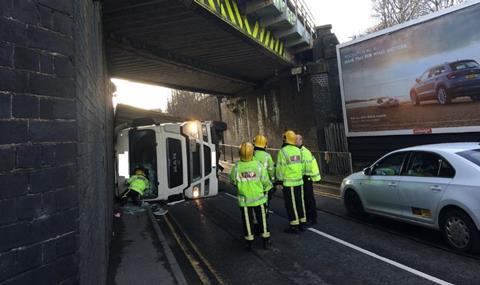
Network Rail has released a list of the most battered bridges in Britain in a bid to raise HGV driver awareness ahead of the Black Friday and Christmas rush.
The list reveals that the Watling Street bridge on the A5 in Hinckley, Leicestershire, has the unenviable title of Britain’s most-bashed bridge after being struck 25 times in the last year.
The second most-struck bridge, the Bromford Road bridge in Dudley, West Midlands, also saw the most rail passenger delays attributed to bridge strikes. Strikes on the bridge saw 4,300 minutes - almost 72 hours - of disruption.
The 20 bridges on the most struck list cover bridges in Norfolk, Scotland, Middlesex, Wiltshire, Cambridgeshire, Staffordshire, Hertfordshire, London, Somerset, West Midlands and Lancashire.
Network Rail figures show railway bridges are struck five times every day on average across Britain, causing almost half a million minutes of delays for rail passengers.
Network Rail added that there has been some improvement, with an 11% decrease in incidents in the last financial year, following a concerted campaign by Network Rail in partnership with Highways England and the Driver and Vehicle Standards Agency (DVSA) and haulage operators.
However, Sir Peter Hendy CBE, chair of Network Rail warned there is more work to be done to cut the still unacceptably high number of bridge strikes.
He said: “We’ve done a lot of work with partners across the industry in recent years to tackle bridge strikes, and whilst it’s encouraging to see our work is paying off with numbers now on the decline, there’s a lot more to be done to cut the unnecessary delays, costs and safety risks they pose.”
Read more
- OTC reveals details of 99 operators reported for bridge strikes
- Network Rail clamps down on HGV operators involved in bridge strikes with ‘Wise Up, Size Up’ campaign
- Network Rail clamps down on HGV operators involved in bridge strikes with ‘Wise Up, Size Up’ campaign
As part of the ongoing campaign to reduce bridge strikes reminders to ‘Wise Up, Size Up’ will feature on petrol pumps at motorway service stations across Britain along with posters, reminding drivers to check their routes before setting off.
In addition a letter was issued by senior traffic commissioner Richard Turfitt last month to all goods vehicle and Public Service Vehicle (PSV) operator licence holders, warning that regulatory action which could result in the loss of their operator’s licence is a real possibility should they fail to take appropriate control measures to prevent bridge strikes.
The letter listed a number of measures operators should take. These include:
• Assess the risks and ensure that routes are planned in advance, so far as is reasonably practicable
• Ensure that drivers, transport managers and planners are properly trained to enable them to assess the risks
• Ensure that drivers are be provided with adequate information including about the vehicles which they are driving.
• In providing information that allows anyone planning or altering a route, operators should consider how to:
• Ensure that drivers have access to height conversion charts
• Ensure that sites have height measurement gauges
• Ensure that each vehicle and trailer in the fleet has an established running height on its technical record
• Ensure that running heights are available to anyone planning a route including drivers who encounter unexpected or unmapped obstructions, such as temporary works.
Hideo Takano, senior structures advisor at Highways England said: “Although bridge strikes are comparatively low for our roads, as part of the collective drive to reduce them happening we work with other transport authorities as part of the Bridge Strike Prevention Group and welcome Network Rail’s new campaign.
“Bridges strikes can cause hours of disruption and although we re-open our roads as soon as possible we recognise the frustration delays can cause.
“Around two-thirds of bridge strikes on our roads are caused by vehicles carrying a load. So, to reduce the risk of this happening we urge all drivers to follow these simple steps; know your height, plan your route and secure your load.”
Gareth Llewellyn, DVSA chief executive said: “There’s real headway being made and we’re seeing a drop in bridge strikes, but we must keep up this momentum to avoid these dangerous and costly incidents.
“You should ensure your drivers are doing their walkaround checks and noting the height of their vehicle every day.
“While DVSA can fall back on regulatory action to deal with bridge strikes, I’d prefer to see no incidents at all, with operators and drivers checking heights before every journey.”














